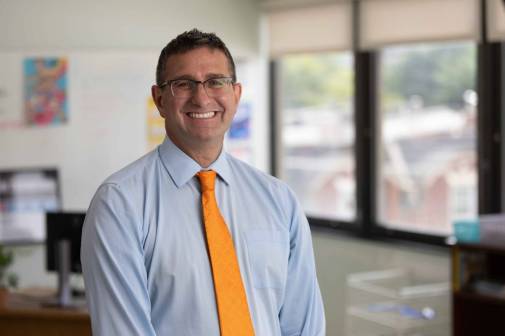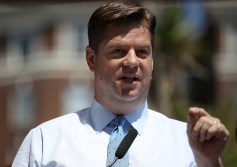Solving homelessness is complicated, two mayors agree

SEATTLE — Ending homelessness is complicated.
That might seem like an obvious message, but it’s one that San Francisco Mayor Ed Lee said he needs to explain to residents on a regular basis when they ask him why he hasn’t mopped up the problem in his city. Between jokes, Lee and Seattle Mayor Ed Murray explained to a packed auditorium at Seattle University on Wednesday evening why homelessness is such an intractable and corrosive social issue.
Both mayors are from Seattle and both are named Ed. That got a few laughs. Lee recounted a story in which he once tried to stop someone from peeing on the sidewalk. The crowd loved that. Murray referenced a meme circulating in Seattle circles in which the mayor is perched atop a bulldozer, demolishing a single-family home to make way for affordable housing units, one of the mayor’s controversial proposals to make headway on the issue.
“They’re cute,” Murray said of the images, out the side of his mouth.
The mayors joked because the room needed lightening, not because they weren’t taking it seriously. Seattle’s King County saw an 84 percent jump in its homeless population between 2011 and 2016. San Francisco’s homeless populations are even bigger at 795 people per 100,000 residents — a figure that puts it second only to New York City.
Spectators sat and crouched in auditorium aisles when all the seats were taken. TV crews and residents had come to hear what these leaders had to say. Despite the crowd, the room frequently became silent when the mayors paused mid-sentence. The crowd waited for the message the men were about to deliver. Do they know something we don’t? Is there actually a solution?
“The human misery that I see every day on our streets, the stories I hear from our staff people that struggle every day and every night, trying to get people the help they need and move them into stable situations and get them the treatment they need, it is simply one of the most painful if not the most painful things I’ve ever dealt with in my life as a person or as an elected official,” Murray said. “I absolutely believe that it’s solvable. I do.”
Seattle’s plan is centered around an initiative — which obtained an additional $12 million in funding in September — called Pathways Home, the mayor’s attempt to end the temporary solutions of most homeless interventions and find a sustainable replacement that could permanently end homelessness in the city. The Seattle mayor was repeatedly questioned by moderators and the audience as to why the city’s new homeless centers — which are to be modeled after San Francisco’s Navigation Center pilot — have not yet been built.
If there’s a millionaire out there who can help out, the city would welcome it, Murray answered — another joke, or maybe a half-joke. Lee later mentioned that some San Francisco billionaires donate heavily to homelessness through their churches and that that assistance is not to be overlooked. The real answer from the Seattle mayor was that the new facility will still come, early this year, but finding a space that had the right plumbing attachments for the showers had delayed progress.
The issue of homelessness extends beyond the logistics of plumbing hookups or overcoming the neighborhood politics surrounding building affordable housing. Murray told stories of his visits to the city’s homeless camps, case workers sometimes returning 47 times to talk to the same homeless people, only to find that scores of these people were not interested in entering a shelter or using any of the city’s services. These were not people looking for handouts, Murray explained — these were chiefly drug addicts and mentally ill people who were either not interested or not able to cooperate.
Shifting from a reactive approach to a proactive approach is at the core of the issue. While each homeless person transitioned into a stable new life is a victory for the leaders who have made it their mission to end homelessness, the issues of mental health, addition, and systemic limitations on the nation’s corrections system provide a steady stream of new homeless people to replace those who have left the streets. On any given night in January 2015, more than half a million people could have been found on American streets with nowhere to go, according to the National Alliance to End Homelessness.
“The status-quo isn’t working,” Lee said. “… As complex as it is, there is no one answer. You can’t be satisfied with brick and mortar. If I build more houses, will I end homelessness? No. You’ve got to have the jobs, you’ve got to end discrimination, you’ve got to deal with drug abuse. … It wasn’t just because the rents were [high], it was that lost job that they couldn’t recover from, it was getting that drug addiction they couldn’t get out of. It was not having a healthcare system that they could get some help with the mental illness challenges. It was nobody was talking about raising the minimum wage so that they can work two jobs instead of three. You have to look at elements of homelessness from the holistic view.”
Murray piled on more complexity.
“I met a woman who wouldn’t leave because she didn’t want to leave her cat,” Murray said. “I met another woman whose husband was in a wheelchair with their son who was also a sex offender and they could not find housing because of his status. I met some of the now-young men who were the Lost Boys of Sudan who are still lost underneath our freeways.”
The two mayors named Ed did not solve homelessness this night, but they enlightened and inspired, a role any leader has the option to fall back on when left with no immediate practical avenues. Whether Seattle or San Francisco or Honolulu — all three cities have recently declared a state of emergency in reaction to increases in homeless populations — will ever be able to create a system within their societies that nurture, educate and support people to the extent that anyone can say homelessness is over, as the mayors endeavor, is impossible to predict. But short of long-term systemic change to how American societies function, there are those who will use their tools and creativity to try to solve the problem anyway.
Several years ago, San Francisco donated some of its decommissioned buses to a woman who turned them into free mobile shower facilities to bring comfort and dignity to people who often find both in short supply. Her organization is called Lava Mae.
Following a data analysis showing frequent requests to clean human feces on city streets, San Francisco now brings toilets mounted on mobile trailers to homeless populations.
Also in San Francisco, a man who was the CEO of a $25 million company before becoming homeless himself, recovered and created an organization called the Learning Shelter, which teaches trades to homeless people so they can feel empowered, get a job and get off the street.
The role technologists play in helping with issues like homelessness is in bringing new stakeholders to the conversation — people who maybe didn’t know they could help — and their talents can help enable new solutions, explained Seattle Chief Technology Officer Michael Mattmiller.
In 2014, Seattle held an event called Hack to End Homelessness that attracted technologists, city employees and community members to think of new ways to solve the problem. That event led to the creation of a nonprofit called WeCount, which uses an app to connect people who need things — like outdoor gear and home goods — directly with people who have things to give.
“Giving someone a backpack might not end homelessness,” the organization’s promotional video says, “but it could start a conversation that secures social services and saves a life.”
Technology and data are the tools that inform the people who make the policies and mold the institutions and systems upon which society relies, Mattmiller explained. It also brings new voices and new ideas into the fold.
On Jan. 17, Seattle and the nation will continue its pursuit of answers at a workshop hosted by the University of Washington, the City of Seattle and the MetroLab Network, a White House initiative designed to improve cities through university-city partnerships.
In attendance will be former Maryland Gov. Martin O’Malley, the MetroLab Network’s national advisor, along with a panel of private and public technologists, educators and policy makers.






